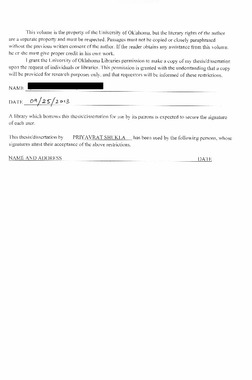| dc.contributor.advisor | Rai, Chandra | |
| dc.contributor.advisor | Sondergeld, Carl | |
| dc.contributor.author | Shukla, Priyavrat | |
| dc.date.accessioned | 2017-08-28T16:20:58Z | |
| dc.date.available | 2017-08-28T16:20:58Z | |
| dc.date.issued | 2013 | |
| dc.identifier.uri | https://hdl.handle.net/11244/51931 | |
| dc.description.abstract | Shale resources promise a new era for energy independence of United States. The promise is intrinsically tied to our ability to economically hydraulic fracture the shale. These extremely tight formations are impossible to produce without hydraulic fracturing, which in turn requires knowledge of mechanical properties of rocks. However, the chemical and mechanical instability of shales sometimes prohibits the recovery of full length cores and/or plugs necessary for conventional mechanical testing. Nanoindentation provides a means to study the mechanical properties of these rocks (essentially the Young's modulus and hardness) using smaller specimen, even drill cuttings, fragments and sidewall cores. The measurements obtained are accurate and reliable and agree well with dynamic measurements. Additionally, the ability of measuring over the whole pay zone through drill cuttings helps in improving hydraulic fracturing design. The technique was essentially developed to measure mechanical properties of small materials and thin films. This thesis focuses on the applicability of nanoindentation in shales. It also attempts to develop a correlation to estimate rock mechanical properties based on the measurements of principal rock components which affect its mechanical behavior; these components include mineralogy, porosity and organic content. Seven different shales comprising a total of 276 samples were tested in this study. Porosity. TOC and mineralogy were measured on all the samples, followed by nanoindentation testing. Nanoindentation testing was carried out in horizontal as well as vertical directions thus enabling the determination of anisotropy in Young's modulus. Vertical Young's modulus ranged between 11 to 93 GPa while horizontal Young's modulus ranged between 30 to 93 GPa. Average ratio of horizontal to vertical modulus was found to be 1.64. Vertical hardness ranged between 0.36 to 6.98 GPa while horizontal hardness ranged between 0.48 to 6.67 GPa. | |
| dc.description.abstract | The precise measurement capability of nanoindenter enables to study the rock frame and organic content separately. Studies were conducted on kerogen to understand the effect of porosity and maturity on the organics. Samples of different organic porosities and maturities were tested. Average Young's modulus in organics was found to be 4 times lesser than that of matrix. This thesis also highlights the variation in mechanical properties when measured on rocks for which bedding directions are known versus randomly oriented simulated drill cuttings. Hydrocarbons are generated and stored at great depths below the Earth's surface. Measurements at high temperatures form another component of this study to understand the effect of temperature on Young's modulus and indentation hardness. 20 samples tested at 100_showed an average increase of 0.1% in Young's modulus from the values at room temperature. Effect of grain size on nanoindentation results is another aspect investigated in this thesis. Results are encouraging and have proved the applicability of nanoindentation on drill cuttings in heterogeneous rocks like shales. | |
| dc.format | xxix, 170 leaves : illustrations (some color), color map ; 28 cm. | |
| dc.language | en_US | |
| dc.subject | Shale -- Testing | |
| dc.subject | Oil-shales | |
| dc.subject | Geochemistry | |
| dc.title | Nanoindentation studies on shales | |
| dc.type | Thesis | |
| dc.type | text | |
| dc.contributor.committeeMember | Devegowda, Deepak | |
| dc.date.manuscript | 2013 | |
| dc.thesis.degree | Master of Science | |
| dc.note | Includes bibliographical references (leaves 152-163). | |
| ou.group | Mewbourne College of Earth and Energy::Mewbourne School of Petroleum and Geological Engineering | |
